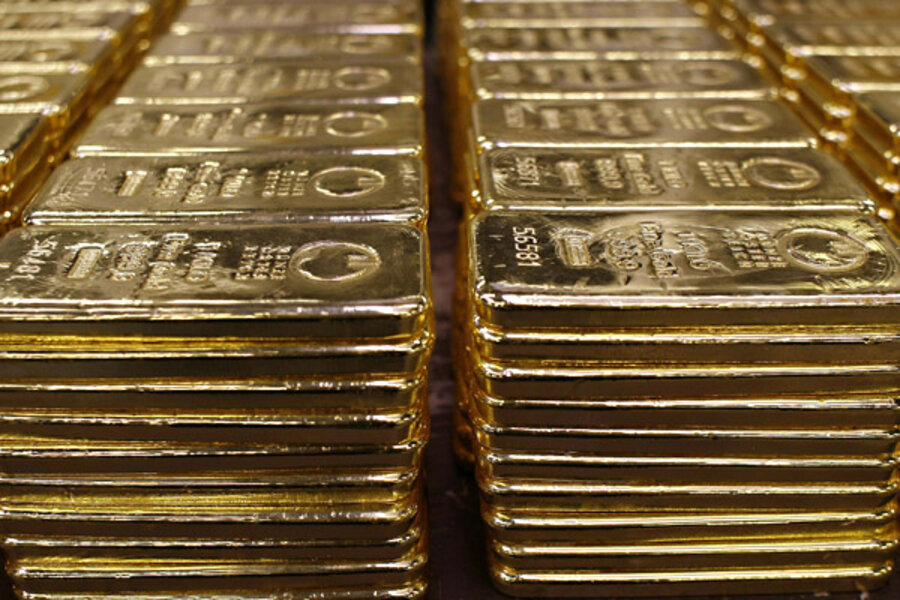Which way will gold swing?
Loading...
Have yourself a merry little depression.
Dow up 45 points. Gold down $9.
We’re still waiting for a major correction in the gold market. Each time one begins, it seems to run out of steam before doing any real damage. At yesterday’s closing price, $1,577, gold is still solidly ahead for the year.
So, where’s the soft spot? Where’s the test? Where will it come from? When?
Don’t worry, dear reader, Mr. Market will test us. He’ll throw his curve ball. We have to be ready.
What if…
…instead of testing us on the downside, he tests us on the upside? This is not a prediction. Just a thought. What if gold suddenly shot up…and looked like it was going to the moon. What would we do?
Citigroup’s metals expert puts a $3,400 price on gold “in the next year or two.”
Jim Rogers makes a similar forecast.
What if they’re right? We only mention it because The Trickster has more than one trick up his sleeve. And he’s perfectly capable of running the price up to $3,500 BEFORE testing us.
We could get giddy, watching the price of gold hit record after record. And then, just when we think it is ready to scale its final peak, gold could turn tail and run for the valley. We wouldn’t believe it. We would hold on. We would wait for it to go back up.
And then…wouldn’t we feel stupid, if we’d taken that ride all the way to over $3,000…and then rode it all the way back to today’s level? Wouldn’t we be put out with ourselves, if we sold out then…thinking gold had put in its final top and we missed it?
According to the 50% principle…it could hit $3,000…collapse to barely $1,500…and then soar again…possibly going to $5,000…or even $10,000. That’s what we’ll get in the final ‘crack up’ boom that is coming.
Who knows?
But what we see is more upside than downside for gold. Because the motor pulling gold up still has a lot of gas in the tank.
In the US the feds spend $1.60 for every dollar they raise in taxes. In Europe, the euro-feds prepare to bail out their banks and sovereign debtors.
And guess how much the feds have already spent? They were so desperate to avoid a debt crisis…or a depression…that they threw the throttle wide open on the biggest rescue effort the world has ever seen. Bloomberg calculated that $7.7 trillion were put to work. Our estimate was higher — about $10 trillion, we guessed.
Well…we were both way off. Here’s the news report:
As part of the Ford Foundation project “A Research and Policy Dialogue Project on Improving Governance of the Government Safety Net in Financial Crisis,” Nicola Matthews and James Felkerson have undertaken an examination of the data on the Fed’s bailout of the financial system — the most comprehensive investigation of the raw data to date.
The extraordinary scope and magnitude of the recent financial crisis of 2007-09 required an extraordinary response by the Fed in the fulfillment of its lender-of-last-resort function.
The bottom line: a Federal Reserve bailout commitment in excess of $29 trillion.
Whoa! The feds put at risk an amount equal to 200% of US GDP. And for what? So that a depression wouldn’t knock 5% off GDP? Even the Great Depression of the ’30s only set the US back by 30% of GDP. A similar setback today would cost the economy less than $5 trillion.
Do you see what we see? Even if it worked — which it didn’t — the feds’ efforts would have been a disaster. Who would spend $29 trillion to save $5 trillion?
But wait. There’s more. This assumes that a depression is unnecessary…or that it doesn’t do any good. We know that’s not true. A depression does a lot of good. It wipes out bad investments and eliminates bad speculators. It forces capital into more productive, more profitable uses. It kills off zombie industries. It retires worn-out industries…and reduces costs so that new industries can arise. It’s the ‘destruction’ that Schumpeter’s ‘creative destruction’ needs.
The more we think about it, the more we’re beginning to like depressions. After scammy bailouts and bogus recoveries, a depression would be something to look forward to.
Bill Bonner
for The Daily Reckoning





